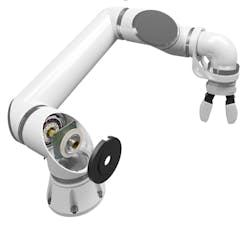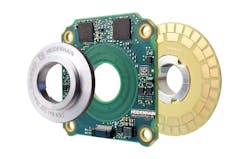In robotics, movements must be precise and well-controlled. As robots are asked to do more as industry becomes more familiar with the technology, there will be an increasing need for high accuracy encoders to provide the position and speed data needed to control them.
One area where this is particularly important is collaborative robots, also known as cobots, which are robots that work in the same space as people. Cobots require precise information on their position and movement to ensure safety is always maintained, but only have limited space available for their different components, thus requiring the use of compact encoders.
Cobots have mass, speed and momentum restrictions to the ensure safety of nearby operators. Critical to cobots’ safety capabilities is the use of one or more rotary encoders at every joint. These encoders must have low mass so that they can be mounted within robot joints without causing the arm to become too heavy and, therefore, unsafe.
Traditionally, two separate encoders are commonly used for robot positioning tasks. When compact dimensions are required, a better solution can be to use a dual rotary encoder, also known as a two-in-one encoder. These encoders can provide motor feedback and position measurement in one device, thus saving space and mass.
Following is a look at the advantages of dual encoders in robotics, using Heidenhain’s KCI 120 Dplus as an example.
Inductive encoder technology
The KCI 120 Dplus consists of a scanning unit and two separate graduated disks, enabling it to independently measure both motor feedback and position from one device. It saves space by only having one main PCB, with all the electronics mounted on it, enabling compact dimensions with a low 20mm profile and a housing diameter of 81mm.
The encoder uses inductive scanning to provide robust, reliable signals. In contrast to magnetic encoders, an inductive encoder is not affected by other nearby magnetic fields.
Inductive encoders are also very resistant to dust, liquids or other contamination and, because they are non-contact devices, they are not vulnerable to long-term mechanical wear. They do not suffer from demagnetization, which can be a problem with magnetic encoders.
Looking at the KCI 120 Dplus specifically, it has axial mounting tolerances of up to ±0.5 mm, making it relatively easy to install. The circular scales of the encoder are simply press-fitted onto the motor shaft and output shaft.
Due to its rigid design, the KCI 120 Dplus can withstand high vibration loads of up to 400 m/s2 on the stator and 600 m/s2 on the rotor.
Accurate measurement
With multiple joints and complicated motion, any inaccuracies in a robot axis of movement add up to potentially create a large overall error. This means that anything that can improve the precision of a particular joint in the robot is invaluable.
In each robot joint there is an electric motor and a gearbox to translate the motion from the motor to actual movements. The gearbox is needed because the motor spins at much higher speeds than required by the robot’s movement. In a standard configuration, there would be a motor encoder and an output encoder on the output from the gearbox.
Instead, when using a two-in-one encoder, we can change the system design and locate the two-in-one encoder downstream from the motor/gearbox assembly. This means that there is the motor, the gearbox and then the two-in-one encoder on the output. Being able to put everything on the output side means that the impact of any play or movement between the motor and the gearbox output shaft is removed. Therefore, we can essentially ignore problems like zero position error, reversal error, any elasticity in the joint itself and any unintended machining effects.
In the two-in-one encoder, the side that attaches to the motor measures speed of rotation, while the other side measures position and is higher resolution to give a more precise reading. There is also a possibility to calculate torque with the KCI 120 Dplus, rather than needing a separate torque sensor.
Additional benefits of a dual encoder
In addition to accuracy and compactness, another benefit to using a dual encoder is a reduction in costs. In terms of purchase price, two encoders typically cost more than a two-in-one encoder. The logistics of managing two encoders is another additional cost that is removed with a dual encoder.
A two-in-one encoder also reduces the number of cables, helping to achieve a compact design and reducing cost and weight. With the KCI 120 Dplus, the signals from the two encoders are sent along a single cable, with Heidenhain’s EnDat 2.2 serial interface enabling the two signals to be combined in one cable.
The KCI 120 Dplus is available with functional safety. It is SIL 2 ready and capable of being integrated into an application with up to SIL 3 safety to minimize malfunctions and facilitate the safe operation of machines and automated systems. This can be especially important for cobot applications to minimize risks in human/robot interactions.
To ensure wide compatibility, the dual encoder is available in three variants. These feature different hollow-shaft sizes and mounting dimensions for the scanning unit and two disk/hub assemblies.
Heidenhain has been working with leading cobot manufacturers to implement the KCI 120 Dplus, and there are high performing cobots on the market that already use this encoder, thus enabling them to achieve greater precision in cutting edge applications.
Stuart Graham is business development specialist at Heidenhain.
About the Author

Leaders relevant to this article:



